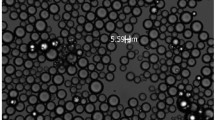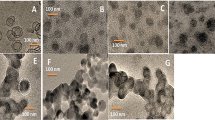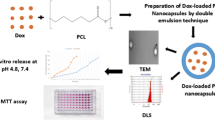Abstract
Doxorubicin is widely used in the treatment of human malignancies, however is associated with significant cardiac, bone marrow and gastro-intestinal toxicity. Delivery systems may ameliorate this toxicity and increase treatment specificity by increasing the proportion of drug delivered to sites of disease. We have developed a novel preparation of doxorubicin (Dox) covalently linked to a heat stabilised human serum albumin microparticle (HSAM) carrier (median particle diameter of 4 μm) and assessed its activity in 4 malignant cell lines.
Materials and methods. Doxorubicin microcapsules were compared with free doxorubicin in the rat carcinoma cell line, WRC256, and the human lines, OVCAR3, MCF7 and the Dox resistant MCF7/Dox, using a cell counting technique. IC50 were calculated from regression analysis of the resulting survival curves. Endocytosis of the microcapsules by cells in culture was observed. The rate of microcapsule uptake was assessed using dual wavelength filtered fluorescence microscopy and flow cytometry.
Results. The mean IC50 following incubation with the Dox microcapsules was around 5 times greater than Dox for WRC256 (p < 0.001), MCF7 (p < 0.01) and for OVCAR3 (p < 0.01). MCF7/Dox was significantly more sensitive to Dox microcapsules than free Dox (p = 0.034). A negative correlation between the rate of microcapsule uptake and the IC50 values for each cell line in culture exists (r = −0.96, p = 0.04).
Conclusions. We conclude that: 1) Doxorubicin microcapsules retain activity in vitro and appear to overcome p-glycoprotein mediated Dox resistance. 2) The observed activity of Dox microcapsules correlates with the rate of particle uptake. Further studies in animal tumour models are in progress.
Similar content being viewed by others
References
Legha SS, Benjamin RS, Mackay B, Yap HY, Wallace S, Ewer M, Blummenschein GR, Freireich EJ: Reduction of doxorubicin cardiotoxicity by prolonged continuous intravenous infusion. Ann Int Med 96: 133–137, 1982
Gupta PK, Gallo JM, Hung CT, Perrier DG: Influence of the stabilisation temperature on the entrapment of adriamycin in albumin microspheres. Drug Develop Indust Pharm 13: 1471–1482, 1987
Gupta PK, Hung CT: Albumin microspheres I: Physicochemical characteristics. J Microencapsulation 6: 426–462,1989
Tomlinson E, Burger JJ, Schoonderwoerd EMA, McVie JG: Human serum albumin microspheres for intra-arterial drug targeting of cytostatic compounds. Pharmaceutical aspects and release characteristics. In: Davis SS, Illum L, McVie JG, Tomlinson E (eds) Microspheres and Drug Therapy. Pharmaceutical, Immunological and Medical Aspects. Elsevier, New York, 1984, pp 75–90
Visscher GE, Pearson JE, Fong JW, Argentieri GJ, Robison RL, Maulding HV: Effect of particle-size on the in vitro and in vivo degradation rates of poly(dl-lactide-co-glycolide) microcapsules. J Biomed Materials Res 22: 733–746, 1988
Goldberg JA, Thomson JAK, Bradnam MS, Fenner J, Bessent RG, Mckillop JH, Kerr DJ, Mcardle CS: Angiotensin-II as a potential method of targeting cytotoxic-loaded microspheres in patients with colorectal liver metastases. Br J Cancer 64:114–119, 1991
Goldberg JA, Willmott K, Kerr DJ, Sutherland C, McArdle CS: An in vivo assessment of adriamycin loaded albumin microspheres. Br J Cancer 65: 393–395, 1992
Cummings, J, Willmott N, Marley E, Smyth JF: Covalent coupling of doxorubicin in protein microspheres is a major determinant of tumour drug disposition. Biochem Pharmacol 41: 1849, 1991
Willmott N, Cummings J: Increased anti-tumour effect of adriamycin-loaded albumin microspheres is associated with anaerobic bioreduction of drug in tumour tissue. Biochem Pharmacol 36: 521, 1987
Astier A, Doat B, Ferrer MJ, Benoit G, Fleury J, Rolland A, Leverge R: Enhancement of adriamycin antitumor-activity by its binding with an intracellular sustained-release form, polymethacrylate nanospheres, in u-937 cells. Cancer Res 48:1835–1841, 1988
Tollemar J, Andersson S, Ringden O, Tyden G: A retrospective clinical comparison between antifungal treatment with liposomal amphoteracin B (Ambisome) and conventional amphoteracinn B in transplant recipients. Mycoses 35: 215–220,1992
Muggia FM, Hainsworth JD, Jeffers S, Miller P, Groshen S, Tan M, Roman L, Uziely B, Muderspach L, Garcia A, Burnettn A, Greco FA, Morrow P, Paradiso LJ, Liand LJ: Phase II study of liposomal doxorubicin in refractory ovarian cancer: Anti-tumour activity and toxicity modification by liposomal encapsulation. J Clin Oncol 15: 987–993, 1997
Gill PS, Espina BRN, Muggia F, Cabriales S, Tulpule A, Esplin JA, Liebman HA, Forssen E, Ross ME, Levine AM: Phase I/II clinical and pharmacokinetic evaluation of liposomal daunorubicin. J Clin Oncol 13: 996–1003, 1995
Forssen EA, Coulter DM, Proffitt RT: Selective in vivo localization of daunorubicin small unilamellar vesicles in solid tumors. Cancer Res 52: 3255–3261, 1992
Matsumura Y, Maeda H: A new concept for macromolecular therapeutics in cancer-chemotherapy - mechanism of tumoritropic accumulation of proteins and the antitumor agent SMANCS. Cancer Res 46: 6387–6392, 1986
Trouet A, Masquelier M, Baurain R, Deprez DE, Campeneere D: A covalent linkage between daunorubicin and proteins that is stable in serum and reversible by lysosomal hydrolases, as 120 required for a lysosomotropic drug-carrier conjugate - in vitro and in vivo studies. Proc Nat Ac Sci USA 79: 626–629, 1982
Hamilton TC, Young RC, McKoy WM, Grotzinger KR, Green JA, Chu EW, Whang-Peng J, Rogan AM, Green WR, Ozols RF: Characterisation of a human ovarian carcinoma cell line (NIH:OVCAR-3) with androgen and estrogen receptors. Cancer Res 43: 5379–5389, 1983
Benchekroun MN, Schneider E, Safa AR, Townsend AJ, Sinha BK: Mechanism of resistance of ansamycin antibiotics in human breast cancer cell lines. Mol Pharmacol 46: 677–684,1994
Zyad A, Benard J, Tursz T, Clarke R, Chouaib S: Resistance to TNF-alpha and adriamycin in the human breast cancer MCF-7 cell line: relationship to MDR1, MnSOD, and TNF gene expression. Cancer Res 54: 825–831, 1994
Mechetner E, Kyshoobayeva A, Zonis S, Kim H, Stroup R, Garcia R, Parker RJ, Fruehauf JP: Levels of multidrug resistance (MDR1) P-glycoprotein expression by human breast cancer correlates with in vitro resistance to taxol and doxorubicin. Clin Cancer Res 4: 389–398, 1998
Ferry DR, Traunecker H, Kerr DJ: Clinical trials of Pglycoprotein reversal in solid tumours. Eur J Cancer 32A: 1070–1081, 1996
Tritton TR, Yee G: The anticancer agent adriamycin can be actively cyto-toxic without entering cells. Science 217: 248-250, 1982
Wingard LJ, Tritton JR, Egler KA: Cell surface effects of adriamycin and carcinomycin immobilized on cross-linked polyvinyl alcohol. Cancer Res 45: 3529–2536, 1985
HenryToulme N, Grouselle M, Ramaseilles C: Multidrug resistance bypass in cells exposed to doxorubicin-loaded nanospheres. Absence of endocytosis. Biochem Pharmacol 50:1135–1139, 1995
Suzuki S, Watanabe S, Uno S, Tanaka M, Masuko T, Hashimoto T: Endocytosis does not necessarily augment the cytotoxicity of adriamycin encapsulated in immunoliposomes. Biochimica et Biophysica Acta - Molecular Cell Research 1224: 445–453, 1994
De Verdiere AC, Dubernet C, Nemati F, Soma E, Appel M, Ferte J, Bernard S, Puisieux F, Couvreur P: Reversion of multidrug resistance with polyalkylcyanoacrylate nanoparticles: Towards a mechanism of action. Br J Cancer 76: 198–205,1997
Robertson KW, Reeves J, Stanton PD, Cooke TG, Ozanne B: Breast cancer cell invasion is modulated by the EGF receptor (Abstract). Br J Cancer 14(Suppl 28): 21, 1996
Nemati F, Dubernet C, de Verdiere AC, Poupon MF, Treupelacar L, Puisieux F, Couvreur P: Some parameters influencing cytotoxicity of free doxorubicin and doxorubicin-loaded nanoparticles in sensitive and multidrug-resistant leukemic murine cells - incubation-time, number of nanoparticles per cell. Int J Pharm 102: 55–62, 1994
Suzuki S, Uno S, Fukuda Y, Aoki Y, Masuko T, Hashimoto Y: Cytotoxicity of anti-c-erbB-2 immunoliposomes containing doxorubicin on human cancer cells. Br J Cancer 72: 663–668,1995
Duncan R, Cable HC, Lloyd JH: Degradation of side chains of N-(2-hydroxypropyl)methacrylamide) copolymers by lysosomal thiolproteinases. Bioscience Rep 2: 1041–1046, 1982
Almquist KC, Loe DW, Hipfner DR, Mackie JE, Cole SPC, Deeley RG: Characterization of the M(r) 190,000 multidrug resistance protein (MRP) in drug-selected and transfected human tumor cells. Cancer Res 55: 102–110, 1995
de Jong S, Zijlistra JG, de Vries EG, Mulder NH: Reduced DNA topoisomerase II activity and drug induced DNA cleavage activity in an adriamycin resistant human small cell lung carcinoma cell line. Cancer Res 50: 304–309, 1990
Anderson JH, Angerson WJ, Willmott N, Kerr DJ, McArdle CS, Cooke TG: Regional delivery of microspheres to liver metastases: the effects of particle size and concentration on intrahepatic distribution. Br J Cancer 64: 1031–1034, 1991
Kato T, Sato K, Sasaki R, Kakinuma H, Moriyama M: Targeted cancer-chemotherapy with arterial microcapsule chemoembolization - review of 1013 patients. Cancer hemother Pharmacol 37: 289–296, 1996
Jain RK: Transport of macromolecules in tumor microcirculation.Biotechnol Prog 1: 81–94, 1985
Jain RK: Transport of molecules across tumour vasculature.Cancer Met Rev 6: 559–593, 1987
Author information
Authors and Affiliations
Rights and permissions
About this article
Cite this article
Eatock, M., Church, N., Harris, R. et al. Activity of Doxorubicin Covalently Bound to a Novel Human Serum Albumin Microcapsule. Invest New Drugs 17, 111–120 (1999). https://doi.org/10.1023/A:1006362915317
Issue Date:
DOI: https://doi.org/10.1023/A:1006362915317




